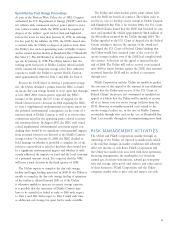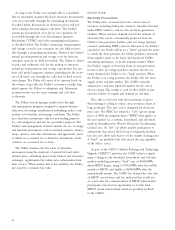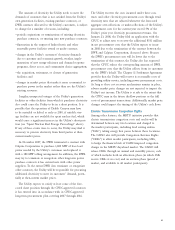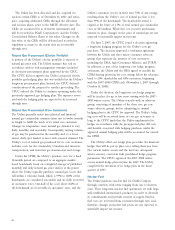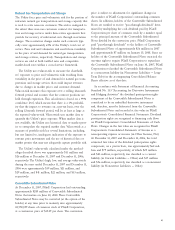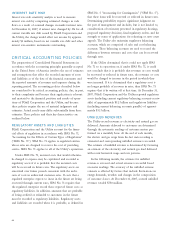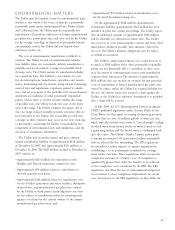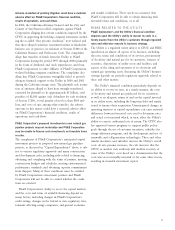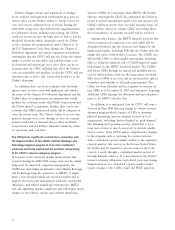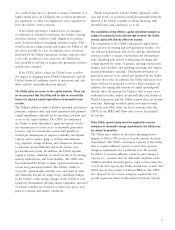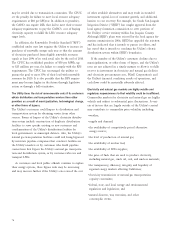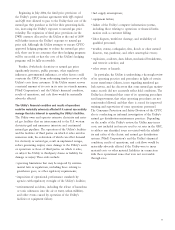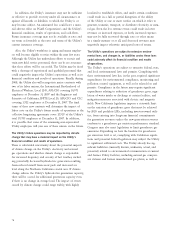PG&E 2007 Annual Report Download - page 70
Download and view the complete annual report
Please find page 70 of the 2007 PG&E annual report below. You can navigate through the pages in the report by either clicking on the pages listed below, or by using the keyword search tool below to find specific information within the annual report.68
ACCOUNTING PRONOUNCEMENTS
ISSUED BUT NOT YET ADOPTED
Fair Value Measurements
On January 1, 2008, PG&E Corporation and the Utility
adopted the provisions of SFAS No. 157, “Fair Value
Measurements” (“SFAS No. 157”), which defi nes fair value
measurements and implements a hierarchical disclosure.
SFAS No. 157 defi nes fair value as “the price that would
be received to sell an asset or paid to transfer a liability in
an orderly transaction between market participants at the
measurement date,” or the “exit price.” Accordingly, an entity
must now determine the fair value of an asset or liability
based on the assumptions that market participants would
use in pricing the asset or liability, not those of the reporting
entity itself. The identifi cation of market participant assump-
tions provides a basis for determining what inputs are to
be used for pricing each asset or liability. Additionally, SFAS
No. 157 establishes a fair value hierarchy which gives prece-
dence to fair value measurements calculated using observable
inputs to those using unobservable inputs. Accordingly, the
following levels were established for each input:
• Level 1 — “Inputs that are quoted prices (unadjusted) in
active markets for identical assets or liabilities that the
reporting entity has the ability to access at the measure-
ment date.”
• Level 2 — “Inputs other than quoted prices included in
Level 1 that are observable for the asset or liability, either
directly or indirectly.”
• Level 3 — “Unobservable inputs for the asset or liability.”
These are inputs for which there is no market data avail-
able, or observable inputs that are adjusted using Level 3
assumptions.
SFAS No. 157 requires entities to disclose fi nancial fair-
valued instruments according to the above hierarchy in each
reporting period after implementation. The standard deferred
the disclosure of the hierarchy for certain non-fi nancial instru-
ments to fi scal years beginning after November 15, 2008.
SFAS No. 157 should be applied prospectively except if
certain criteria are met. CRRs held by the Utility meet the
criteria and will be adjusted upon adoption to comply with
SFAS No. 157 requirements. CRRs allow market participants,
including LSEs, to hedge the fi nancial risk of CAISO-
imposed congestion charges in the MRTU day-ahead market.
PG&E Corporation and the Utility are still evaluating the
impact of the adjustment to price risk management assets
and regulatory liabilities on their Consolidated Balance
Sheets. The costs associated with procurement of CRRs are
currently being recovered in rates or are probable of recovery
in future rates; therefore, the adoption of SFAS No. 157 will
not have an impact on net income.
Fair Value Option
In February 2007, the FASB issued SFAS No. 159, “The Fair
Value Option for Financial Assets and Financial Liabilities”
(“SFAS No. 159”). SFAS No. 159 establishes a fair value
option under which entities can elect to report certain
fi nancial assets and liabilities at fair value, with changes in
fair value recognized in earnings. SFAS No. 159 is effective
for fi scal years beginning after November 15, 2007. PG&E
Corporation and the Utility do not expect the adoption of
SFAS No. 159 to materially impact the fi nancial statements.
Amendment of FASB Interpretation No. 39
In April 2007, the FASB issued FASB Staff Position on
Interpretation 39, “Amendment of FASB Interpretation
No. 39” (“FIN 39-1”). Under FIN 39-1, a reporting entity is
permitted to offset the fair value amounts recognized for
cash collateral paid or cash collateral received against the fair
value amounts recognized for derivative instruments executed
with the same counterparty under a master netting arrange-
ment. FIN 39-1 is effective for fi scal years beginning after
November 15, 2007, and will affect the Utility’s Consolidated
Balance Sheets as of March 31, 2008. The impact of FIN 39-1
on PG&E Corporation’s and the Utility’s balance sheets is
currently being evaluated. PG&E Corporation and the Utility
do not expect any earnings impact as a result of the adoption
of the amendment, as FIN 39-1 only affects the balance sheet.
TAXATION MATTERS
See Note 11 of the Notes to the Consolidated Financial
Statements for discussion of taxation matters.



